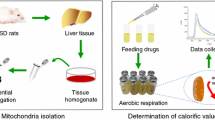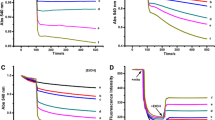Abstract
The effects of lanthanum on heat production of mitochondria isolated from Wistar rat liver were investigated with microcalorimetry; simultaneously, the effects on mitochondrial swelling and membrane potential (Δψ) were determined by spectroscopic methods. La3+ showed only inhibitory action on mitochondrial energy turnover with IC50 being 55.8 μmol L−1. In the spectroscopic experiments, La3+, like Ca2+, induced rat liver mitochondrial swelling and decreased membrane potential (Δψ), which was inhibited by the specific permeability transition inhibitor, cyclosporine A (CsA). The induction ability of La3+ was stronger than that of Ca2+. These results demonstrated that La3+ had some biotoxicity effect on mitochondria; the effects of La3+ and Ca2+ on rat liver mitochondrial membrane permeability transition (MPT) are different, and La represents toxic action rather than Ca analogy.





Similar content being viewed by others
References
Wang CR, Lu XW, Tian Y, Cheng T, Hu LL, Chen FF, Jiang CJ, Wang XR (2011) Lanthanum resulted in unbalance of nutrient elements and disturbance of cell proliferation cycle in V. faba L. seedlings. Biol Trace Elem Res 143(2):1174–1181
Cui JA, Zhang ZY, Bai W, Zhang LG, He X, Ma YH, Liu Y, Chai ZF (2012) Effects of rare earth elements La and Yb on the morphological and functional development of zebrafish embryos. J Environ Sci-China 24(2):209–213
Feng ZX, Zhang SG, Yang KY, Ni JZ (1996) Influence of intraperitoneal injection of rare earth compounds on the activity of antioxidant enzymes and the level of lipid peroxidation in mice livers. J Rare Earth 14(1):66–69
Hayes JD, Flanagan JU, Jowsey IR (2005) Glutathione transferases. Annu Rev Pharmacol Toxicol 45:51–88
Marubashi K, Hirano S, Suzuki KT (1998) Effects of intratracheal pretreatment with yttrium chloride (YCl3) on inflammatory responses of the rat lung following intratracheal instillation of YCl3. Toxicol Lett 99:43–51
Zhao HQ, Cheng J, Cai JW, Cheng Z, Cui YL, Gao GD, Hu RP, Gong XL, Wang L, Hong FS (2012) Liver injury and its molecular mechanisms in mice caused by exposure to cerium chloride. Arch Environ Contam Toxicol 62(1):154–164
Wang QQ, Lai Y, Yang LM, Huang BL (2001) Preliminary study of existing species of lanthanum in the spinach leaves after being cultivated with a culture solution containing lanthanum. Anal Sci 17(6):789–791
Shan XQ, Wang HO, Zhang SZ, Zhou HF, Zheng Y, Yu H, Wen B (2003) Accumulation and uptake of light rare earth elements in a hyperaccumulator Dicropteris dichotoma. Plant Sci 165(6):1343–1353
Wang XP, Shan XQ, Zhang SZ, Wen B (2003) Distribution of rare earth elements among chloroplast components of hyperaccumulator Dicranopteris dichotoma. Anal Bioanal Chem 376(6):913–917
Wu B, Zhang D, Wang D, Qi CY, Li ZY (2012) The potential toxic effects of cerium on organism: cerium prolonged the developmental time and induced the expression of Hsp70 and apoptosis in Drosophila melanogaster. Ecotoxicology 21(7):2068–2077
Scott I, Logan DC (2008) Mitochondria and cell death pathways in plants: actions speak louder than words. Plant Signal Behav 3(7):475–477
Huang PL, Li JX, Zhang SH, Chen CX, Han Y, Liu N, Xiao Y, Wang H, Zhang M, Yu QH, Liu YT, Wang W (2011) Effects of lanthanum, cerium, and neodymium on the nuclei and mitochondria of hepatocytes:accumulation and oxidative damage. Environ Toxicol Pharmacol 31(1):25–32
Lee HC, Wei YH (2000) Mitochondrial role in life and death of the cell. J Biomed Sci 7(1):2–15
Dai J, Li CL, Zhang YZ, Liu Y (2008) Microcalorimetric investigation on effects of La-III on metabolic activity of mitochondria isolated from hybrid rice. Chem Biodivers 5(12):2684–2689
Wu M, Gao JL, Sun MX, Zhang YZ, Liu Y, Dai J (2015) Effects of La(III) and Ca(II) on isolated Carassius auratus liver mitochondria: heat production and mitochondrial permeability transition. Biol Trace Elem Res. doi:10.1007/s12011-014-0178-2
Liu Y, Chen D, Chen AJ, Dong ZY, Nie YX, Lu R, Ni JZ (2003) Study on lanthanum deposit in liver of rats chronically exposed to lanthanum nitrate at low dose. J Health Toxicol 17:203–205
Zhang Y, Li JH, Liu XR, Jiang FL, Tian FF, Liu Y (2011) Spectroscopic and microscopic studies on the mechanisms of mitochondrial toxicity induced by different concentrations of cadmium. J Membr Biol 241(1):39–49
Drahota Z, Milerová M, Endlicher R, Rychtrmoc D, Cervinková Z, Ostadal B (2012) Developmental changes of the sensitivity of cardiac and liver mitochondrial permeability transition pore to calcium load and oxidative stress. Physiol Res 61:S165–S172
Xiong TC, Jauneau A, Ranjeva R, Mazars C (2004) Isolated plant nuclei as mechanical and thermal sensors involved in calcium signaling. Plant J 40(1):12–21
Halestrap AP, Clarke SJ, Javadov SA (2004) Mitochondrial permeability transition pore opening during myocardial reperfusion—a target for cardioprotection. Cardiovasc Res 61(3):372–385
Di Lisa F, Bernardi P (2006) Mitochondria and ischemia-reperfusion injury of the heart: fixing a hole. Cardiovasc Res 70(2):191–199
Crompton M (1999) The mitochondrial permeability transition pore and its role in cell death. Biochem J 341(2):233–249
Hu ZY, Richter H, Sparovek G, Schnug E (2004) Physiological and biochemical effects of rare earth elements on plants and their agricultural significance: a review. J Plant Nutr 27(1):183–220
Mei QM, Zhu YG (1990) Comparative study on mitochondrial DNA from cytoplasmic male sterile lines of Honglian type and Yebai type rice. J Wuhan Bot Res 8(1):25–33
Luo X, Budihardjo I, Zou H, Slaughter C, Wang XD (1998) Bid, a Bcl2 Interacting protein, mediates cytochrome c release from mitochondria in response to activation of cell surface death receptors. Cell 94(4):481–490
Gornall AG, Bardawill CJ, David MM (1949) Determination of serum proteins by means of the biuret reaction. J Biol Chem 177(2):751–766
Wadsö I (2002) Isothermal microcalorimetry in applied biology. Thermochim Acta 394(1–2):305–311
Liu HX, Yuan L, Yang XD, Wang K (2003) La3+, Gd3+ and Yb3+ induced changes in mitochondrial structure, membrane permeability, cytochrome c release and intracellular ROS level. Chem Biol Interact 146(1):27–37
Zamzami N, Marchetti P, Castedo M, Zanin C, Vayssière JL, Petit PX, Kroemer G (1995) Reduction in mitochondrial potential constitutes an early irreversible step of programmed lymphocyte death in vivo. J Exp Med 181(5):1661–1672
Liu Y, Deng FJ, Zhao RM, Shen XS, Wang CX, Qu SS (2000) Microcalorimetric studies of the toxic action of La3+ in mitochondria isolated from Star-cross 288 chicken heart tissue cells. Chemosphere 40(8):851–854
Zheng D, Liu Y, Zhang Y, Chen XJ, Shen YF (2006) Microcalorimetric investigation of the toxic action of Cr(VI) on the metabolism of Tetrahymena thermophila BF5 during growth. Environ Toxicol Pharmacol 22(2):121–127
Zhao YL, Wang JB, Zhang P, Shan LM, Li RS, Xiao XH (2011) Microcalorimetric study of the opposing effects of ginsenosides Rg(1) and Rb(1) on the growth of mice splenic lymphocytes. J Therm Anal Calorim 104(1):357–363
Nedergaard J, Canno B, Lindberg O (1977) Microcalorimetry of isolated mammalian cells. Nature 267:518–520
Xie CL, Tang HK, Song ZH, Qu SS (1988) Microcalorimetric study of bacterial growth. Thermochim Acta 123:33–38
Hou AX, Xue Z, Liu Y, Qu SS, Wong WK (2007) Antibacterial effects of a monoporphyrinato ytterbium(III) complex and its free components on Staphylococcus aureus as determined by stop-flow microcalorimetry. Chem Biodivers 4(7):1492
Kanno T, Sato EE, Muranaka S, Fujita H, Fujiwara T, Utsumi T, Inoue M, Utsumi K (2004) Oxidative stress underlies the mechanism for Ca(2+)-induced permeability transition of mitochondria. Free Radic Res 38(1):27–35
Szewczyk A, Wojtczak L (2002) Mitochondria as a pharmacological target. Pharmacol Rev 54(1):101–127
Tyler G (2004) Rare earth elements in soil and plant systems—a review. Plant Soil 267(1–2):191–206
Wang K, Li RC, Cheng Y, Zhu B (1999) Lanthanides—the future drugs. Coord Chem Rev 190–192:297–308
Nilsson JR, Coleman JR (1977) Calcium-rich refractiles granules in Tetrahymena pyriformis and their possible role in the intracellular ion regulation. J Cell Sci 24(5):311–325
Feng XD, Xia Q, Yuan L, Yang XD, Wang K (2010) Impaired mitochondrial function and oxidative stress in rat cortical neurons: implications for gadolinium-induced neurotoxicity. NeuroToxicology 31(4):391–398
Brustovetsky N, Brustovetsky T, Jemmerson R, Dubinsky JM (2002) Calcium-induced cytochrome c release from CNS mitochondria is associated with the permeability transition and rupture of the outer membrane. J Neurochem 80(2):207–218
Acknowledgments
We gratefully acknowledge the financial support of the project by the National Natural Science Foundation of China (No. 21173026, 21225313) and the Key Program of Natural Science Foundation of Hubei Province (No. 2013CFA107).
Conflict of Interest
The authors declare no conflict of interest.
Author information
Authors and Affiliations
Corresponding author
Rights and permissions
About this article
Cite this article
Wu, M., Gao, JL., Feng, ZJ. et al. Study on Biological Effects of La3+ on Rat Liver Mitochondria by Microcalorimetric and Spectroscopic Methods. Biol Trace Elem Res 167, 63–69 (2015). https://doi.org/10.1007/s12011-015-0269-8
Received:
Accepted:
Published:
Issue Date:
DOI: https://doi.org/10.1007/s12011-015-0269-8




